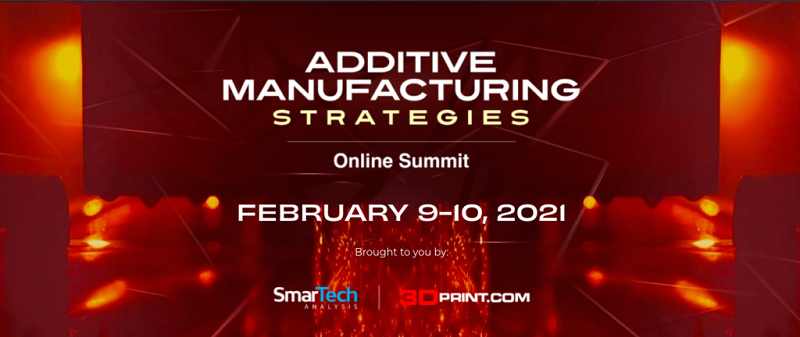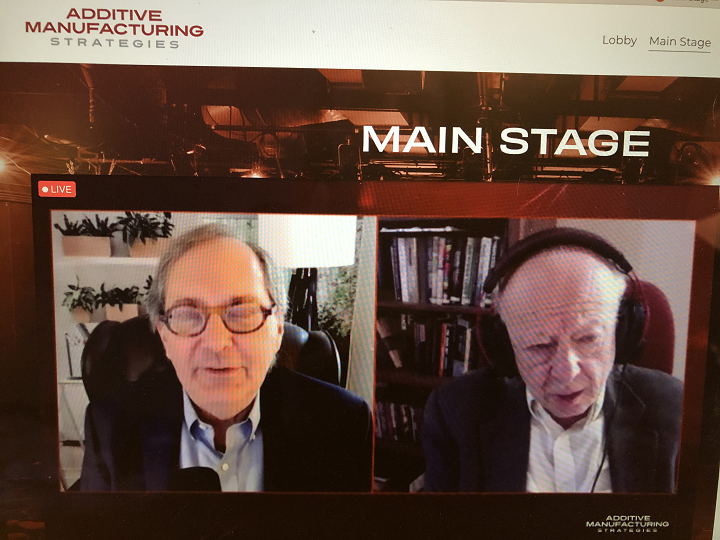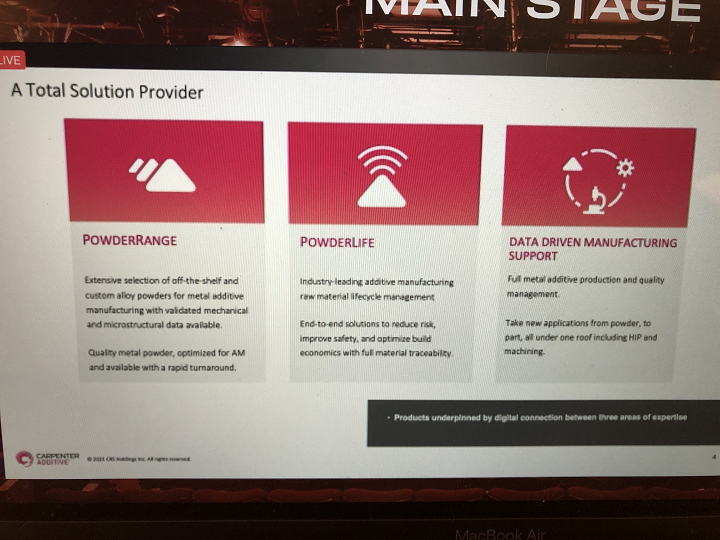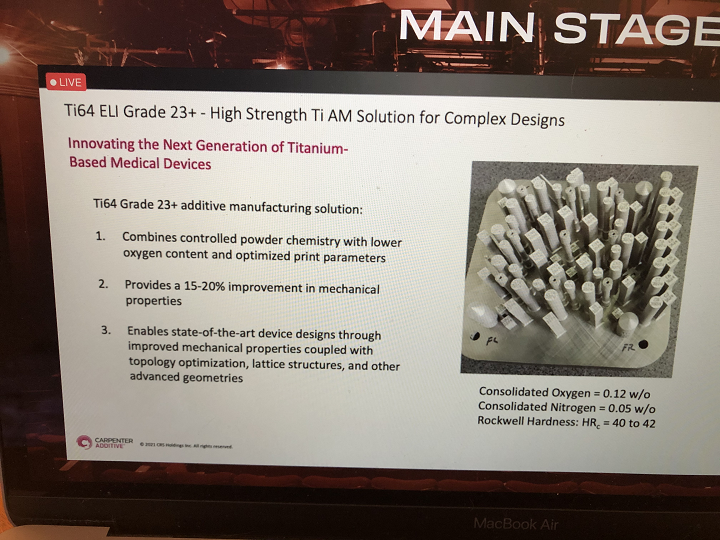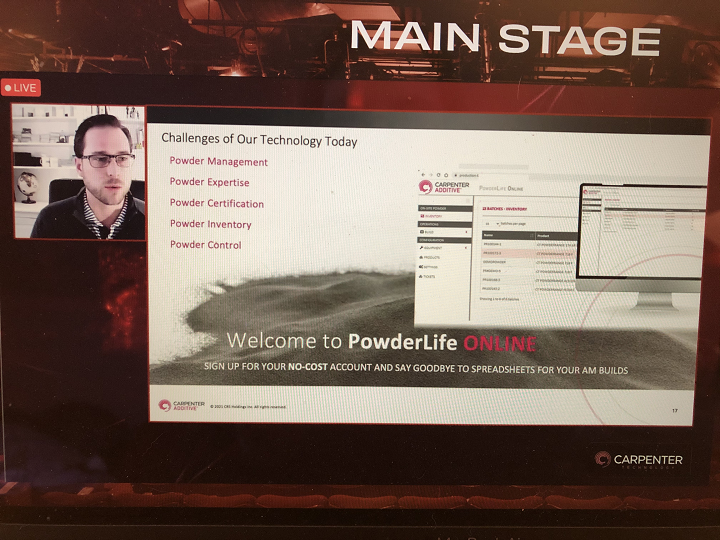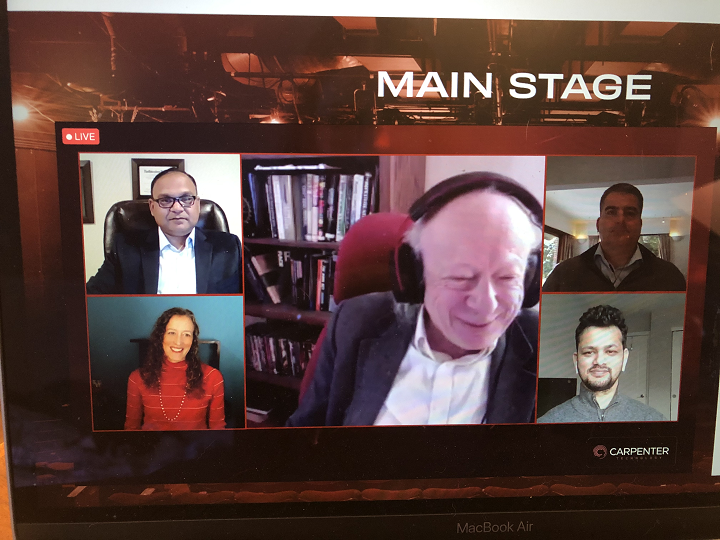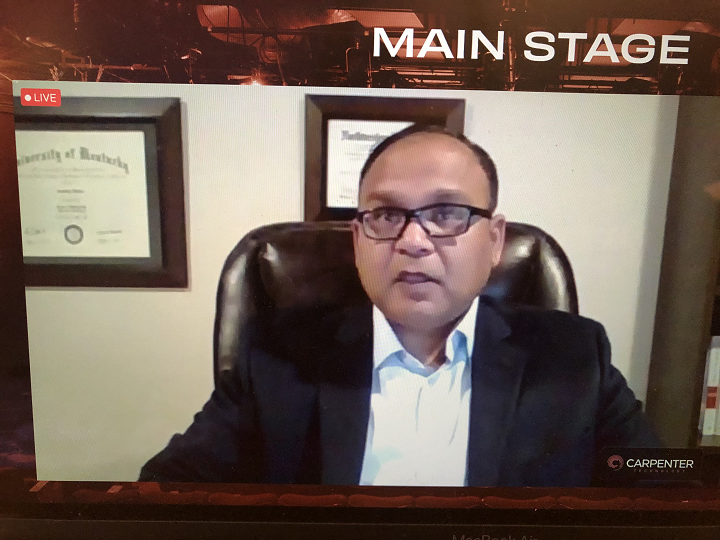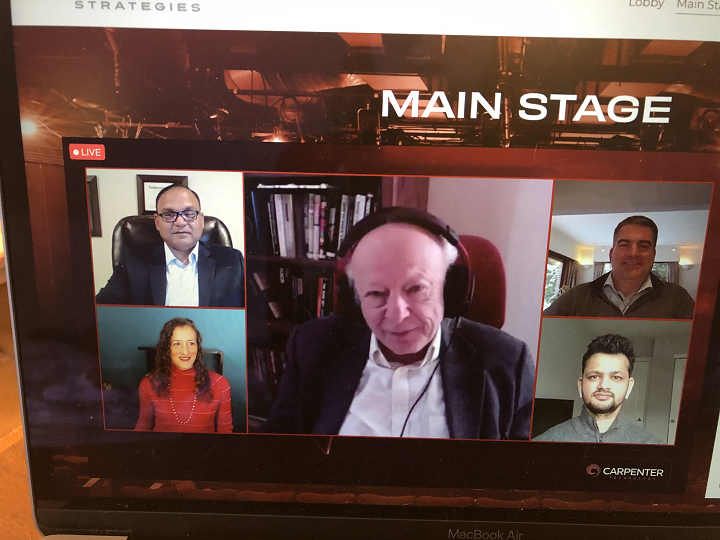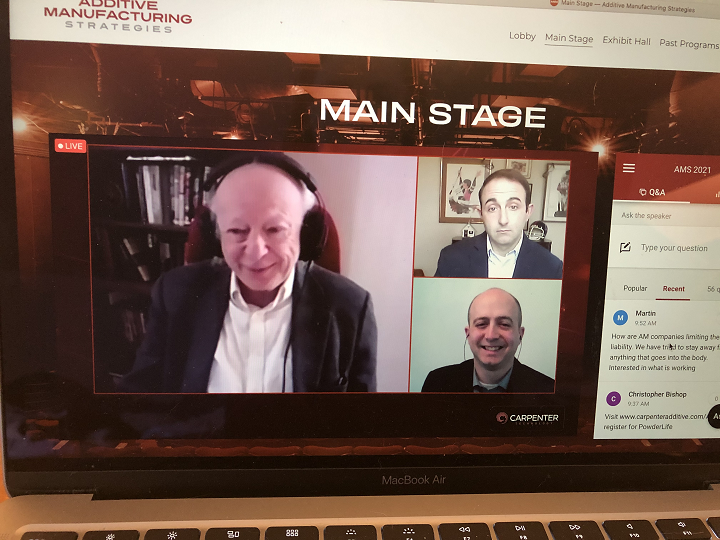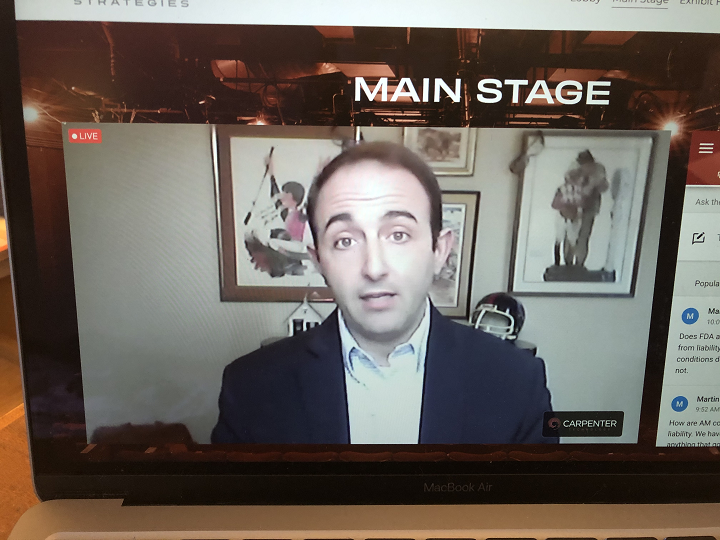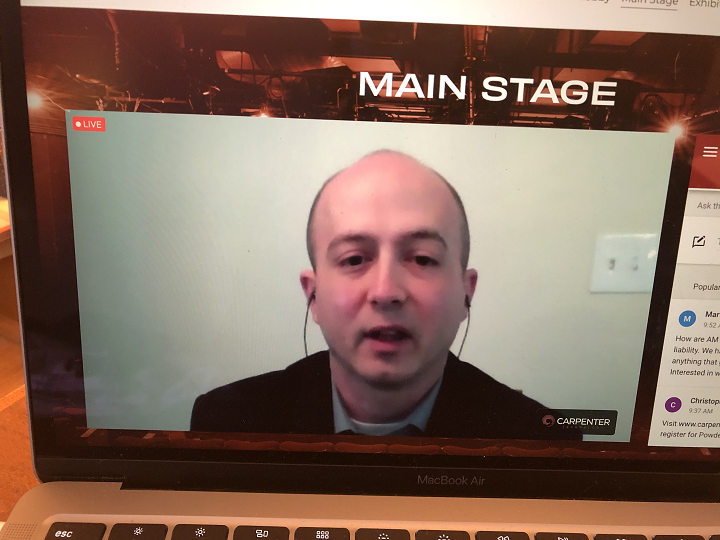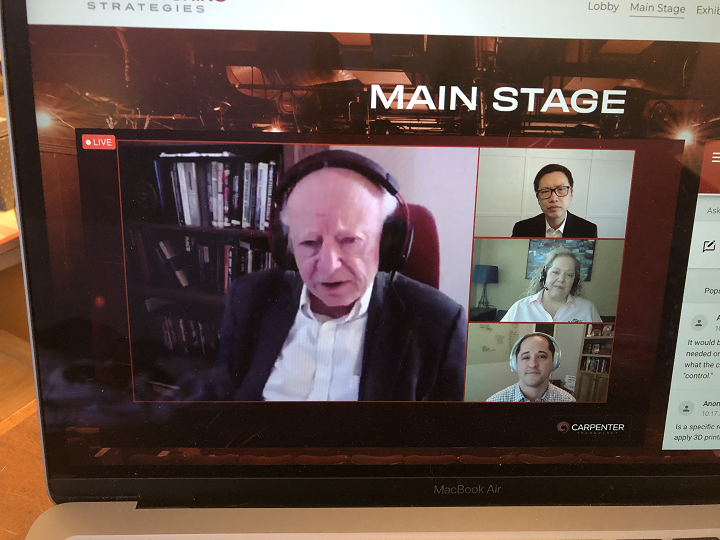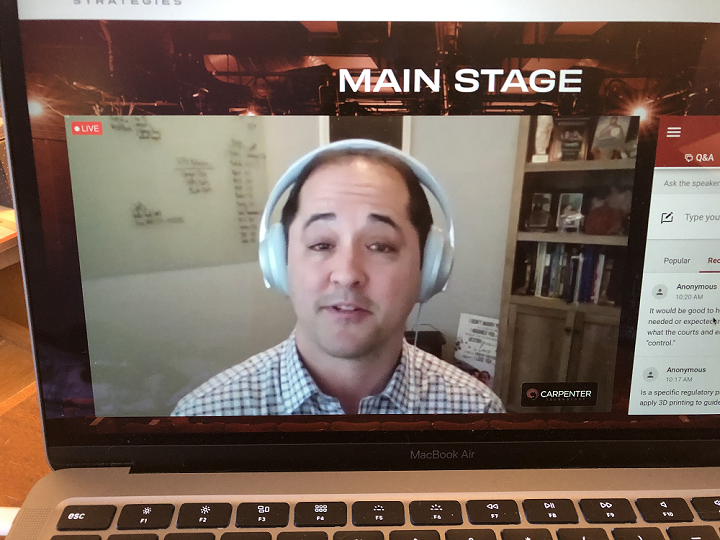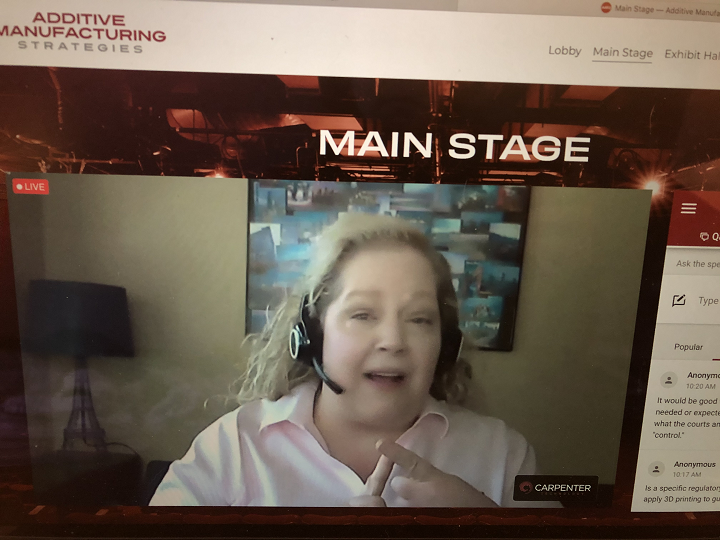Additive Manufacturing Strategies 2021, co-hosted by 3DPrint.com and SmarTech Analysis, held its fourth summit in a virtual format. Each day focused on two verticals, with the focus first on metal and new materials, and then automation and software on day one. Day two started with medical and dental 3D printing and the event closed with bioprinting in the afternoon.
Master of Ceremonies and technology futurist Christopher Bishop, Chief Reinvention Officer for Improvising Careers, said that, although we wish we could be together in person, there is something to be said hosting about a virtual event, as we had attendees from 25 different countries, and 26 U.S. states. He also reminded us that all of the AMS 2021 sessions were being recorded and archived, so attendees could access the videos until February 28th if they missed something.
Moderator Lawrence Gasman, the President of SmarTech Analysis, introduced the opening keynote presenters from topic sponsor Carpenter Technology Corporation, Ben Ferrar and Gaurav Lalwani.
Ferrar, the Vice President and General Manager of Carpenter Additive, explained that Carpenter is working in three main areas: R&D, raw materials, as it’s one of the world’s largest gas atomized powder producers, and production, with a focus on validation and process optimization.
Then he introduced Carpenter’s three major product ranges: PowderRange, PowderLife, and data-driven manufacturing support.
Lalwani, the company’s Global Applications Engineering Lead, took the floor, so to speak, to discuss recent material developments in the medical field, and said that the orthopedic space mainly uses titanium (Ti64 ELI Grade 23), due to its biocompatibility, corrosion resistance, and high-strength. But, he noted two major challenges with this material: during high temperature 3D printing, “the powder readily oxidizes,” which can cause brittleness and cracking, and the material’s reusability is limited by the oxidation process.
“This is an industry-wide problem, and we need to go back to the drawing board and find a solution,” he stated.
He explained that any issues, as well as good mechanical properties, have to do with the powder’s chemistry, which does change with use.
As to what affects powder degradation, Lalwani said that laser beams can lead to “a lot of splatter,” which contains nitrogen and oxygen, inside the build chamber. This splatter forms particles on the surrounding surfaces, which “can act as points of failures” when they fall back into the powder bed.
“What we have come up with is Ti64 ELI Grade 23+, which allows for complex designs,” he said.
Lalwani said this new Carpenter material offers better mechanical properties, and gives designers more freedom to create complex designs.
As for PowderLife, Ferrar said that what’s affecting the industrialization of AM are factors like powder reuse, health and safety, contamination, repeatability, environmental control, traceability, and unconnected data sources. At least some of this is due to the fact that most AM powders aren’t designed specifically for the platforms on which they’re being used.
“PowderLife is an ecosystem of closed-loop powder handling solutions made possible through integration of multiple components,” he explained. “The piece that ties these together is our software.”
PowderLife can be used for powders made by other suppliers, and the company itself has used its PowderLife software solution to manage, as Ferrar said, “thousands of products and batches of material.” Carpenter’s new entry-level solution, PowderLife Online, allows customers to see Carpenter’s full range of powders and their own inventory, as well as set up and start builds and load powder; reported benefits include better quality and powder cost reductions.
Gasman next introduced the participants for “Implants and Orthopedics,” the vertical’s first panel: 3D Systems’ Gautam Gupta, Vice President and General Manager, Medical Devices; Philip Oris, Business Development Director Healthcare, SLM Solutions; Global Medical Business Development Manager for EOS Laura Gilmour; and Carpenter’s Lalwani.
Gupta stated that 3D Systems is “primarily focused on two things at a high level: innovation in personalized medicine space through an end-to-end portfolio, and facilitating supply chain scaling for manufacturing of spinal implants through several channels.” Oris explained that SLM Solutions is all about metals.
“Our equipment is close to powder handling systems, as well as selective laser melting technology, which allows maxillofacial and spinal customers to get high quality products,” he continued.
Gilmour said that EOS, which offers polymer and metal printers, “historically works with medical device customers,” enabling them to use the technology through the company’s Additive Minds program and teaching them “all they need to know so they can apply it to the next project.” She did note that EOS is seeing more projects for polymer than metal these days, for dental applications and prostheses.
Lalwani mentioned again how Carpenter focuses on producing high-quality AM powder by using its materials knowledge and metallurgical expertise “to optimize materials for the additive process.”
“It’s the same material, but with some tweaks to the chemistry, it can be optimized,” he explained.
Gasman asked the panelists if personalized medicine was going to be “a thing in the industry,” stating that we always write and talk about it like it’s the way of the future, but wondering if it would actually happen.
“We are seeing increased emphasis and requirement for personalized solutions,” Gupta answered, noting 3D Systems’ recent news about receiving 510(k) clearance from the FDA for a custom ankle device. “For more than 20 years, we’ve serviced the craniomaxillofacial industry through our Virtual Surgical Planning, which is customized to every patient. Typically the costs have been pretty high, so the adoption has been, from a supply chain point of view, tough to turn things around quickly. But I absolutely believe there’s an increased interest in customers asking about economically viable solutions that can be personalized.”
Gupta did note the inherent challenges in reimbursement and insurance for personalized 3D printed medical devices.
Oris said that 3D printing applications for personalized medicine began nearly two decades ago with products like surgical guides. But, he believes that the industry will soon see an emergence of 3D printed implants made of cobalt-chromium.
“I tend to look at the clinical side of it, and historically medical additive manufacturing has been used in the hip joint,” Gilmour responded. “But personalized medicine, in terms of metal, I don’t know that it will be cost-effective for everyone. Also, what happens with trauma? And I don’t think we know the answer yet. But on the polymer side, I think there are more opportunities for personalized medicine, such as hearing aids and dental implants.”
Lalwani mentioned increased interest for personalized implants, but also noted there were many challenges here.
“When it comes to customized implants, you need to be able to turn things around in a fairly quick and robust fashion,” he said. “I think personalized implants will have their own niche space, maybe with areas of trauma where there is a lot of bone loss.”
Gasman then asked what new materials we should be on the lookout for in the next five to ten years.
“What we’re seeing now, if you look at the space, most use titanium,” Lalwani answered. “But some applications, like instrumentation, you can bring in stainless steels. With large joints and extremities, you have cobalt chrome.”
He also mentioned some of the other next-generation material systems Carpenter is working on, including Nitinol and a cobalt-free alloy.
“I think with materials, you still have to look at the whole process chain,” Gilmour said. “So it’s easier to look for materials that already have clinical history, due to regulations.”
She agreed that Nitinol is a “really interesting” material, and noted that polymer materials with softer impact force “may be the way things are going.”
“I think medical is a little bit boring in materials, unfortunately, because we rely on the clinical history, and even something like tantalum can be difficult,” Gilmour said. “There’s also the balance with cost, such as with cobalt-chrome. Sometimes the business case may just not be there.”
Gupta agreed with Gilmour’s take, stating that the regulatory aspect “makes it difficult to keep innovating with new materials for implant applications.”
“We’re focusing on nylon and other plastics for disposable implementation, and other tissue-like materials that can be used for anatomical models,” he said. “Titanium has been the preferred material for bone ingrowth applications, and the industry has started research into multimaterial printing, which is very difficult, but hopefully at some point we’ll figure out how titanium and cobalt-chrome can be printed together.”
Oris, after stating that he supported and emphasized with what the other panelists had said, cautioned the need to make “a distinct separation between industrial and medical.”
“The medical device industry will need to be cautious adopting these new alloy formulations. It’s not a matter of can it be printed, but can it be printed with caution?”
Gasman then began the second panel, “Regulatory and Legal Trends in Medical 3D Printing,” which featured two speakers: Dr. Matthew Di Prima, a Research Materials Scientist for the U.S. Food and Drug Administration (FDA), and Sean Burke, a partner at Duane Morris in the Washington, DC office whose practice focuses on representing medical device manufacturers in product liability cases across the country.
“There’s a need for regulation and oversight in medical 3D printing, and the reasons for that hardly require explanation,” Gasman said, introducing what he called the elephant in the room.
Dr. Di Prima is a technical expert who informs the FDA about what’s going on in the additive manufacturing industry.
“We have a fairly well-defined custom device section, so from a macro point of view, the pathway to regulatory compliance is similar,” he said. “In 2017, we released a technical guidance on 3D printed medical devices, and at the time it was lacking references to consensus standards, so we’ve been working on that over the last few years.
“I’ll say the new and interesting thing is we see more people coming in trying to get clearance for a fleet of systems, as opposed to just one, which has led to interesting questions about how to validate a fleet of 3D printers to make medical devices.”
Burke explained that his practice is focused at the other end of the spectrum: defending companies against threats of liability.
“What stands out to me is that the challenges and unique aspects of additive manufacturing just don’t fit in some of the most established legal tenets that we’ve relied on for decades,” he said. “So that means you have to protect against the unknown. Intellectual property and products liability raise a lot of unique issues. The pandemic has really showed how additive manufacturing solutions can be quickly set up, but outside that, you can see IP concerns, like reverse engineering or pirating a file. Patents normally protect tangible products, not the digital file.”
Mentioning point-of-care (POC) medicine, Burke said that in terms of products liability, “some of the basic questions we’ve always known the answers to before are now unknown,” such as the creator of a medical device on a site like Thingiverse.
“It’s unclear if we can call a CAD file a product or not. So we as attorneys can help protect you,” he said.
Gasman kicked things up a notch, noting that products liability seems “to be at the core of many things,” and asked who or what would be addressing this for 3D printed medical products: case law, legislation, or those like Dr. Di Prima, “who are in the relevant part of the government to help ease things along.”
“That’s a hard question on many levels,” Dr. Di Prima said. “The safe answer for us is that the mass majority of products coming through the FDA going through 510(k) clearance are for moderate-risk products, and not high-risk ones. We haven’t had to focus too much on truly high-risk printed products just yet.”
Burke answered that the courts would sort things out in this context, and noted that the best tool for this is regulatory compliance. He said that when explaining a case like this to a jury, having FDA compliance for the product in question is extremely important.
“With additive manufacturing, there have been some recalls already, and some lawsuits. But as the technology is still emerging, a lot of it is about preparing, and how you can best structure your design files,” he explained. “A lot of what you design now will be judged by a jury of your peers in the future. So what can you do to make sure your files are as good as they can be?”
Dr. Di Prima, who is a leader on the Nitinol material we kept hearing about, said his center employs 170 medical research device experts, and that “with every submission when they’re doing something new on the material processing side, the FDA does look at the risk.”
“In October of last year, we released final guidance for medical devices containing Nitinol, so it listed the conditions that the FDA would look to see had been addressed. At the end of the day, people are still getting products with Nitinol approved, so there is a pathway for it. I think adding 3D printing and Nitinol together would be challenging, and I’m sure it will end up on my desk, so I’m excited to see what people do with it.”
Gasman asked about the scientific complexities of Nitinol in the context of legislature or in the courtroom, and Burke said it’s always a challenge to explain why a certain material or technology was used when the original product, made with a more conventional material or technology, has already been on the market a long time.
“Whenever you deviate, you have to explain the importance of innovation, the science behind it, the reasoning, why it was a good idea…make documentation files of all of it, and why you’re doing what you’re doing, because they’ll be scrutinized 10-15 years later. If you explain what you were doing, that’s really beneficial if you’re defending in court.”
Gasman finished things up by asking about challenges with 3D printed POC medical devices, and Dr. Di Prima said that the FDA has been working to address this ever since the agency really started looking at 3D printing, which was over six years ago.
“There’s lots of questions surrounding this space, and every time we come up with an answer and we go to the next level, we find that it hasn’t addressed some concern,” he explained. “It’s difficult in the regulatory space. It would take a full day to talk through all of that. We’ve been working hard internally and having discussions with external stakeholders to lay out a possible framework for hospitals to work in this space.”
Burke agreed, noting that “the challenge is the unknowns.”
“Last year after AMS, many people came up to me and were like, oh we’re a materials company, we won’t have liability issues, right? So you need to really look at your supply contracts here,” he urged.
The third panel “End-User Hospitals and Clinical Experiences,” was my favorite. Moderated once again by Gasman, the panelists were Dr. Albert Woo, Associate Professor of Surgery, Pediatrics and Neurosurgery, at Brown University’s Warren Alpert Medical School; Lauralyn McDaniel, Industry Manager for ASME; and Scott Drikakis, Healthcare Segment Leader at Stratasys.
Dr. Woo, a plastic surgeon by training, started the 3D printing lab at Washington University, and did the same thing at Brown. He specializes in craniofacial surgeries, for “individuals with severe facial trauma who need reconstruction.” McDaniel, previously the industry manager of medical device manufacturing at SME, has been working in the AM field for more than twenty years, primarily focusing on the medical field and helping the community find answers to challenges in this area. Drikakis has also spent twenty years working in the additive healthcare field.
Gasman asked the panelists what challenges they see in hospitals using 3D printing today, and where it made sense to use it versus where it didn’t.
“This is a very complicated question to answer,” Dr. Woo said. “There are multiple aspects to be discussed.
“Medicine as a field is extremely conservative, because we’re in charge of people’s lives. So hospitals are very particular about making sure anything we put in a patient is very safe, so we have a culture of trepidation.”
He said one of his challenges as a medical 3D printing enthusiast is how to get other clinicians to use the technology, noting that it’s not easy to move people out of their comfort zones “when they’ve had reasonably good results doing what they’ve already done.”
McDaniel said that she asks POC providers what issues they’re having, and workforce and reimbursement are two big ones.
“Other issues are the speed of the machines, the materials, and the regulatory process – where is the line between practicing medicine and being a manufacturer?”
Drikakis agreed with both, adding that quality and the type of necessary infrastructure to adopt a POC program were two other issues he’d add, along with how the 3D printed models are used.
“A lot of it is about awareness: what are the goals, what do you want to accomplish? We also have to make sure there’s that awareness that we’re doing no harm by implementing these models into the operating room, or influencing diagnostic use,” he stated.
Gasman said that additive manufacturing in hospitals is still pretty new, and asked the panelists how exactly they went about marketing the technology.
“We’re not trying to sell machines. We’re trying to improve outcomes, and give clinicians another tool,” Drikakis said. “It goes to clinical appropriateness—when has it shown to be useful, and not?”
He discussed the critical importance of knowing when 3D printing should be used, and when it’s less relevant or unnecessary.
“In healthcare, anything less than 20 years old is new, and that’s where we are in the continuum of adopting the technology,” Drikakis continued.
Dr. Woo said in terms of marketing, he thinks his hospital wonders what in the world he’s doing sometimes.
“I’m very passionate about the subject, I consider myself a bit of an evangelist and give presentations all the time about 3D printing,” he explained. “We’re talking about a culture change, and that doesn’t happen overnight. You need individuals who really are able to break out of their self-imposed box and think larger. I’ve got a number of colleagues who are adopting the technology now, and we’re seeing it used more for complex spine tumors, specifically.”
McDaniel said that Dr. Woo is “a prime example of the best way to get 3D printing adopted in a hospital.”
“You need a champion, someone who believes in it,” she explained. “I’ve worked to try to get more people interested by bringing forth those champions and having them talk to their colleagues and peers.”
Gasman then asked the panelists what they were seeing in the area of POC printing, and Drikakis said the topic comes up frequently in a country with more than 6,000 hospitals.
“So what needs to be in place for this to be more broadly adopted? Reimbursement is one piece, but from a regulatory and quality perspective, we need a procedure in place to adopt it,” he said. “Also the awareness that 3D printing is available and viable, and where it could and could not be used.”
Dr. Woo stated that he is a firm believer in POC printing, mentioning that he has a 3D printer right in his office, which is where the models are fabricated. He’s also invested in a startup called Implant3D that’s looking specifically at POC printing.
“It’s the way of the future,” he said. “By performing POC, you can eliminate issues with delivery and transfer of healthcare information.”
McDaniel said she’s seen a lot of headway here over the last five years, such as new hospital-focused standards in development, best practices, and job competency models.
“The other thing that’s been very encouraging, from 2019 into 2020 there was a huge increase of clinical studies, which is a big part of evidence-based medicine,” she continued. “Before, you’d only find one or two. Over twenty of them are taking place using 3D printing now, which is a huge step forward for everyone.”
Finally, Gasman asked how important reimbursement was to the adoption of 3D printing in the medical field. McDaniel noted that there will be some hospitals that go ahead without waiting for direct reimbursements for devices like surgical guides and medical models, because “they find the overall value supports the outcome.”
“But for it to expand to overcome the reluctance of hospitals, having CPT codes that are reimbursable is critical,” she said.
Dr. Woo agreed, stating that reimbursement is vital because while hospitals do care about the patient, “they need to balance their bottom lines.”
“If we get reasonable reimbursement and hospitals can make reasonable money, this will explode multifold.”
The final panel was “AM Dental,” moderated by SmarTech’s Executive Vice President of Research Scott Dunham. The panelists were Les Kalman, Assistant Professor of Restorative Dentistry at Western University’s Schulich School of Medicine; Gabi Janssen, Application Development Specialist for Medical & Dental with DSM Additive Manufacturing; and Beth Collington, the Director of Digital Materials and Laboratory Equipment, Global Prosthetic Solutions, with Zahn Dental, the laboratory side of Henry Schein Inc.
Kalman is a full-time educator who’s moving into metals as part of his research, while Janssen is responsible for developing next-generation materials, which she explained were “really important to getting a full solution and safe, high-quality product.” Collington says that Zahn Dental works with team leaders around the world to “collaborate on innovative technologies and materials, so we can select what will be game-changers for our customers.”
Dunham asked about the status of AM in dentistry and dental care, and if there has been a long-term downturn due to COVID.
“When the pandemic hit last year, we did have a shutdown, dental services and education both stopped,” Kalman said. “Currently, clinical education is still limited because of the number of people allowed in a room, and private practices are up and running, but elective surgery is down because patients can be a little hesitant.”
Collington said that Zahn also had a big shutdown, but that the company used the time off “to build education platforms for our customers” and spoke with some of the industry’s key opinion leaders about how to rebuild.
“We’ve seen a strong business comeback, though we are constantly adapting to the changes COVID has brought to the industry,” she said.
Janssen said that it was quite a shock in the beginning of the pandemic, and that DSM “looked to see what we could do to help and support people,” such as making door openers.
“We now have a very limited amount of people in the labs, and that’s still slowing development a bit.”
Dunham asked where 3D printing is used in the dental industry that’s really exciting, such as cosmetic dentistry, surgical guides, and in-office activities.
“I think one of the most established pieces of the market are the models,” Collington said. “We’re seeing a big push into the orthodontic space with the models, and we’re also seeing aligners.”
She mentioned the rise of digital dentures, which really shows the good possibilities that can come from a traditionally analog product moving to a digital workflow with the option to provide an even better product.
“That will explode in the next few years,” Collington said.
Janssen agreed that the aligner market is seeing some rapid growth, as the “ability to scan and shorten the timeline for planning treatment really pushes the AM industry.” She also noted that high-quality, low-cost solutions that are local can help reduce transportation time.
“I could talk all day about this,” Kalman said. “In the plastics, we have an alternative approach to fabricating something. But then with metal printing, in the device space, we can create a product that we couldn’t before, so it’s been a game-changer for us. The strength is really going up.”
Dunham next asked about “the fine line with metals vs. ceramics” in the dental industry.
“Dentists are pretty housed in tradition, very evidence-based. So it takes a while to be adopters,” Kalman explained. “But in the metal and ceramics space, they’re diverging. What we’re seeing is a new platform.”
He also mentioned that he’s seen some promising zirconia results in the dental AM space as well.
“I think one other point is that it’s exciting to watch the industry unfold,” Collington added. “This technology is so accessible to everyone. As people learn to make materials with better chemical solubility, it will be adopted even more.”
Dunham began reading some of the questions from attendees, starting with the future of centralized vs. decentralized 3D printing. Janssen said it depends on the application, because paying a high price for the equipment can be difficult to do some in places, and Collington agreed with her.
“Is everyone old enough to remember actual film cameras? I think it’s a very similar analogy,” Kalman said, explaining how when photography went digital, everyone rushed out and bought a digital camera, albeit of poor quality. “With 3D printing, we all got the $100 crappy printers for home. It’s hard to compare the expensive machines with the desktop chairside ones.”
Collington mentioned that she’s starting to see materials with excellent aesthetics for digital dentures, along with higher pixel resolutions with DLP technology, “which helps bring a much smoother finish to the models, really necessary for restorations.”
“So the accuracy is getting better, and now we’re seeing price points come down,” she said. “That will make some people adopt the technology to independent businesses.”
Another attendee asked what some of the more commonly used AM technologies were for dental applications, and Dunham answered this one, stating that mainly vat photopolymerization systems were used for orthodontic applications, as well as surgical guides and models. Janssen said powders are used a lot for dental models, and Collington mentioned water-soluble materials, due to a “big push for recycling in the lab space.”
“Materials are exciting, but let’s not forget workflows,” Kalman cautioned. “If we can get a denture in a patient’s mouth in half the time in comparison to the conventional workflow, I think we’re succeeding.”
Urging others to keep the product workflow in mind was one of the common themes of the medical/dental 3D printing vertical for AMS 2021. It’s not always about the latest flashy toy or material: sometimes you need to take a step back and look again at the big picture to truly innovate. 3D printing won’t work for every single use case, and that’s okay; we should always remember to first do no harm.
Subscribe to Our Email Newsletter
Stay up-to-date on all the latest news from the 3D printing industry and receive information and offers from third party vendors.
You May Also Like
Gorilla Sports GE’s First 3D Printed Titanium Cast
How do you help a gorilla with a broken arm? Sounds like the start of a bad joke a zookeeper might tell, but it’s an actual dilemma recently faced by...
Nylon 3D Printed Parts Made More Functional with Coatings & Colors
Parts 3D printed from polyamide (PA, Nylon) 12 using powder bed fusion (PBF) are a mainstay in the additive manufacturing (AM) industry. While post-finishing processes have improved the porosity of...
$25M to Back Sintavia’s Largest Expansion of Metal 3D Printing Capacity Since 2019
Sintavia, the digital manufacturing company specializing in mission-critical parts for strategic sectors, announced a $25 million investment to increase its production capacity, the largest expansion to its operations since 2019....
Velo3D Initiates Public Offering in a Bid to Strengthen Financial Foundations and Drive Future Growth
Velo3D (NYSE: VLD) has been among a number of publicly traded 3D printing firms that have attempted to weather the current macroeconomic climate. After posting a challenging financial report for 2023,...


